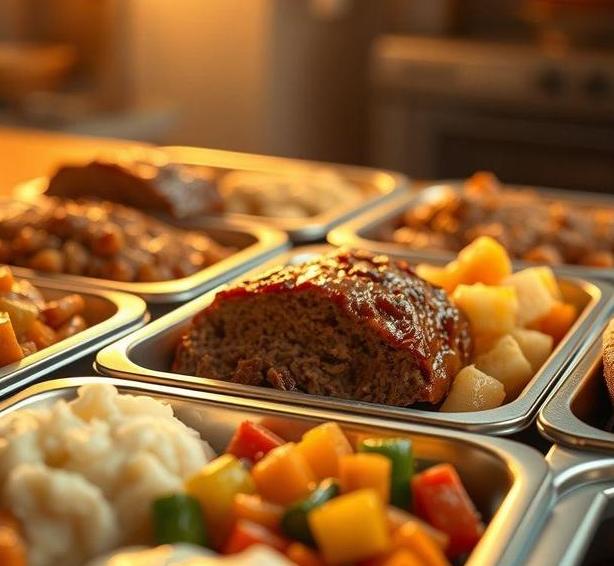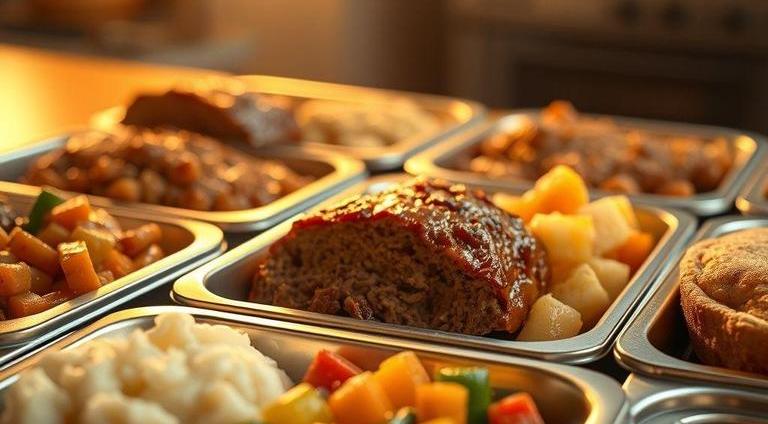TV dinners, those convenient and nostalgic frozen meals, have been a staple in households for decades. Whether it’s the classic Salisbury steak or the more modern lasagna varieties, these meals offer a quick and hassle-free solution to feeding yourself when time is tight or you’re just not in the mood to cook. But here’s the thing: like all food products, TV dinners have a limited lifespan, and if they aren’t stored or handled properly, they can go bad. So, how long can these frozen meals last? And how can you tell if they’ve passed their prime? Let’s dive into all of this in detail, so you can safely enjoy your favorite frozen meals without worrying about foodborne illness or subpar taste.
Can Tv Dinners Go Bad?
Absolutely. While TV dinners are designed to have long shelf lives, they’re not immune to the effects of time, temperature, and improper storage. Despite being frozen, TV dinners can still spoil for a number of reasons. Here’s why:
- Freezer Burn: If the dinner is stored improperly, moisture can evaporate from the food, leaving it dehydrated and tough. The texture and taste will be affected, even though it might still be safe to eat.
- Temperature Fluctuations: If your TV dinner has thawed and refrozen multiple times, bacteria may have had a chance to grow during the thawing process, which could lead to spoilage.
- Packaging Issues: If the seal on the packaging is broken or compromised, contaminants like air and moisture can cause the meal to deteriorate more quickly.
- Expired Ingredients: TV dinners usually have preservatives, but they can only extend the shelf life for so long. Eventually, even preservatives lose their power, and the ingredients will start to break down.
So, while frozen meals are pretty resilient, they’re not invincible.
Shelf Life For Tv Dinners

The shelf life of a TV dinner varies depending on the type of meal and how it’s stored. However, the general rule of thumb is as follows:
- Frozen Meals in a Stable Freezer: Most TV dinners can last anywhere from 3 to 6 months in a properly maintained freezer. This time frame allows for optimal taste and texture. However, they’ll still be safe to eat beyond this period, although their quality may start to decline.
- Microwaveable TV Dinners: If you’re looking at a meal that has been partially prepared, or that comes with sauce packets and vegetables, it may have a shorter shelf life, typically around 3 months.
- Specialty Dinners (Low-fat, Gluten-free, etc.): These might have a slightly shorter lifespan due to the lack of preservatives or the presence of fresh ingredients. Expect them to last for 2 to 4 months.
- Homemade Frozen TV Dinners: If you’ve prepped your own TV dinner and froze it, expect it to last about 2 to 3 months. The lack of commercial preservatives can cause it to degrade faster than store-bought options.
It’s always a good idea to check the packaging for any "best by" or "use by" dates to get a better sense of the expected shelf life.
Common Signs Of Spoilage
Knowing when a TV dinner has gone bad is important to prevent foodborne illnesses and unwanted flavors. Here are the key signs to look out for:
- Off or Sour Smell: If your TV dinner emits an unpleasant or sour odor when you open it, it’s a strong indicator that the food has spoiled.
- Ice Crystals or Frost: If there are large ice crystals inside the package, it’s a sign that the meal has been thawed and refrozen, which can lead to bacteria growth. Excess ice also causes freezer burn, affecting the taste and texture.
- Color Changes: If the meal has changed color (e.g., meat turning grey or vegetables becoming discolored), it’s an indication that the food has started to break down.
- Odd Texture: If the meal feels overly mushy, tough, or slimy when you touch it or after cooking, it’s another warning sign that the food is no longer safe to eat.
- Packaging Damage: If the packaging is swollen, punctured, or leaking, bacteria could have entered, compromising the meal. This is especially true for vacuum-sealed or tightly sealed TV dinners.
- Unusual Taste: If, after reheating, the meal tastes different-whether overly salty, sour, or just off-it’s likely no longer safe to eat.
When in doubt, it’s always better to toss it out. Food poisoning is not worth the risk of finishing a meal that has been sitting in your freezer for too long.
How To Store Tv Dinners?

Proper storage is key to extending the life of your TV dinners and ensuring they remain safe to eat. Here’s how to store them correctly:
- Keep the Freezer at the Right Temperature: Your freezer should be at 0°F (-18°C) or lower. This will help maintain the quality and safety of the food.
- Check the Seal: Make sure that the packaging is sealed tightly. If it’s been opened or punctured, transfer the meal into an airtight container or reseal it with heavy-duty freezer bags or plastic wrap.
- Avoid Temperature Fluctuations: Try not to open the freezer door too often or leave the door open for long periods. This can cause temperature fluctuations, leading to thawing and refreezing, which ruins the meal’s quality.
- Label and Date: If you’re storing homemade TV dinners or if you’ve had a meal in the freezer for a while, it helps to write the date on the packaging. This way, you can monitor how long it’s been in the freezer and avoid keeping it past its prime.
- Don’t Stack Too Much: Overloading the freezer can impede air circulation, which makes it harder for your frozen meals to stay at a consistent temperature. Ideally, try to leave space between items.
- Proper Freezer Bags or Wrapping for Homemade Meals: If you’re making your own TV dinners, wrap them tightly with freezer wrap or store them in vacuum-sealed bags to reduce the risk of freezer burn.
Expert Tips
Here are a few expert tips to make sure you’re getting the most out of your TV dinners:
- Don’t Refreeze: If a TV dinner has thawed, it’s generally not safe to refreeze it. Freezing and thawing can create conditions for bacterial growth, even if the meal looks okay.
- Freeze Right After Buying: When purchasing frozen meals, it’s best to get them into your home freezer as soon as possible. If they sit in your car or at room temperature for too long, you risk partial thawing, which can shorten their shelf life.
- Avoid Keeping Them Too Long: Even though they can last months, remember that TV dinners taste best within the first few months. After six months, the quality will begin to degrade, even if they’re still safe to eat.
- Cook from Frozen: If you’re preparing your meal from the freezer, cook it directly from frozen. Thawing it first can result in uneven cooking and may leave the meal at risk of bacteria growth.
- Don’t Overcook: Overcooking your TV dinner can dry it out, so always follow the instructions to the letter for the best results.
FAQs
Can TV Dinners Go Bad If Left Out At Room Temperature?
Yes, TV dinners can go bad if left out at room temperature for extended periods. Perishable foods in TV dinners, such as meat and dairy, can develop harmful bacteria after about 2 hours. It is important to refrigerate or freeze them promptly to prevent foodborne illnesses.
How Long Can TV Dinners Stay In The Freezer?
TV dinners can typically stay in the freezer for up to 3-6 months if stored properly. Beyond this time, the food may begin to lose its quality, flavor, and texture, even though it may still be safe to eat.
Can TV Dinners Go Bad After The Expiration Date?
TV dinners can still be safe to eat after the expiration date if they have been stored correctly, but the quality may decline. The expiration date is a guideline for the best taste and texture, not a strict safety indicator. Always inspect the meal for signs of spoilage, such as an off smell or discoloration.
What Are Signs That A TV Dinner Has Gone Bad?
Signs that a TV dinner has gone bad include a sour or rancid smell, a change in texture (such as mushiness or freezer burn), discoloration, or the presence of ice crystals on the packaging. Any of these can indicate that the meal is no longer safe to eat.
Can TV Dinners Go Bad In The Refrigerator?
Yes, if TV dinners are stored in the refrigerator for too long, they can spoil. Typically, they should be consumed within 1-2 days after being refrigerated, especially if they were previously cooked or contain ingredients like dairy or meat.
Can Microwaveable TV Dinners Go Bad?
Yes, microwaveable TV dinners can go bad just like other frozen or pre-packaged meals. If they are not stored at the proper temperature or kept for too long, they can become unsafe to eat. Always follow storage instructions on the packaging and check for spoilage before consumption.
How Can You Tell If A Frozen TV Dinner Has Gone Bad?
If a frozen TV dinner has gone bad, you may notice freezer burn, which appears as white, dried-out spots on the food. The texture may also change, becoming rubbery or overly dry. Additionally, if the packaging is damaged or swollen, this could indicate bacterial growth, and the meal should be discarded.
Can TV Dinners Cause Food Poisoning If They Go Bad?
Yes, TV dinners can cause food poisoning if they go bad due to bacterial growth, such as Salmonella, E. coli, or Listeria. If a TV dinner has been improperly stored, especially if left out at room temperature, it can develop harmful pathogens that may lead to foodborne illnesses.
Is It Safe To Eat A TV Dinner That Has Thawed And Refrozen?
It is generally not safe to eat a TV dinner that has been thawed and refrozen. This can allow harmful bacteria to grow, which could lead to food poisoning. It is best to cook the TV dinner immediately after thawing to ensure safety.
Can TV Dinners Go Bad Even If They Are Still Sealed In Their Packaging?
Yes, TV dinners can still go bad even if they are sealed in their packaging. While the packaging helps to preserve the food, improper storage conditions, such as exposure to heat or moisture, can cause the food to spoil. Always check the expiration date and inspect the meal before eating.